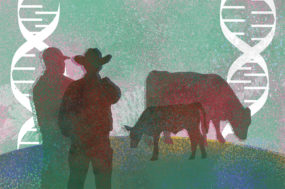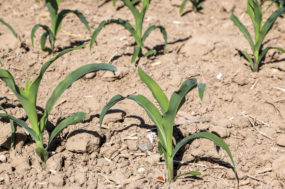- Antibiotic resistance is highly complex and is subject to interpretation, and misinterpretation.
- Resistance can be transferred from humans to animals, as well as from animals to humans.
- Antimicrobial resistance occurs not only in food-production animals and in humans but in companion animals as well.
- Evaluating antimicrobial resistance involves balancing risks vs. needs while constantly recognizing the importance of maintaining an efficacious arsenal of human antibiotics.
- Food-borne illnesses declined 29 percent in the last decade, but reports in the media have increased 150 percent.
- No antibiotic is 100 percent effective.
- Most classes of antibiotics used in food animals are not used in humans.
- Significant efforts are being led by the public health community to reduce inappropriate antibiotic prescribing in human health and reduce hospital-acquired infections. Agriculture needs to be open to change as well.
- Food animal production should enforce current regulations and address any antibiotic misuse or be prepared for an unfavorable outcome. (Click here for the full report.)
Part-time drylotting of beef cows
Pasture and range for maintaining beef cows may be reduced due to periodic drought, competition for land from crop production, other uses such as recreation and urbanization, and environmental regulations. Over three years, 80 mature spring-calving Red Angus X Simmental cows were maintained during May-October on either native range or in drylot with about 1,200 square-feet/cow-calf pair and 2 feet bunk space/cow.
The drylot ration (which varied depending on availability, nutrient content and price) was mostly crop residue and grain co-products, with some corn silage and grass hay. Creep feed was available to calves in drylot and on range. All cows were exposed to natural service.
Over the three years, cows averaged 1,512 pounds in May when turned out on range or started on the drylot treatment. Range cows lost 54 pounds and drylot cows 105 pounds to end of breeding. Percent assisted births were higher in drylot. There was little difference in conception rate, calf birth date, calf birth weight or calf weight in May.
From May to weaning, range calves gained 40 pounds more. Cost of maintaining drylot cows was $1.72/day compared to $1/day for range. Total cost/pound of calf weaned was $1.02 for drylot and 79 cents for range.
Note: While drylot was more costly in this study, temporary management in drylot may be an economical alternative especially during severe drought. Cost of nutrition should be a key concern if drylotting is considered, especially for extended periods. (2013 North Dakota Beef Report, p. 13)
What is residual beef intake?
For many years, efficiency has generally been measured as the ratio of feed required to produce a pound of gain (usually termed feed conversion), or less often as the reverse or gain from a pound of feed (usually termed feed efficiency). In the case of feed conversion, a smaller number equates to higher efficiency.
With gain/feed a larger number means higher efficiency and so is easier to understand, especially in relationships to other production factors. With either of these measures, animals that eat more in relation to their weight tend to gain faster and more efficiently. This is usually explained as greater consumption means a smaller proportion of consumption is needed to maintain the animal, so more is available for production.
In recent years residual feed intake (RFI) has been increasingly used as a measure of feed efficiency. In fact, the concept was proposed over 50 years ago. RFI compares actual feed consumption to what would be predicted based on an animal’s gain. If an animal consumes less than predicted then RFI is negative and the animal is more efficient.
Once again, as with feed conversion, a negative value is more efficient. (In some cases, the reverse is calculated as residual average gain or RADG, where positive values are more efficient.) RFI has been found to be independent of gain, so there are fast-gaining and slow-gaining animals with the same RFI.
It is not known exactly what causes difference in RFI. In a paper studying Angus steers from genetic lines selected for either low or high RFI, the amount of variation in RFI explained by various factors was: 1) protein turnover, tissue metabolism, and stress (37 percent), 2) digestibility (10 percent), 3) heat increment and fermentation (9 percent), 4) physical activity (9 percent), 5) body composition (5 percent) 6) feeding patterns (2 percent), 7) undetermined factors (28 percent).
The authors noted that some of these factors are either difficult to measure or may be ignored, resulting in inaccurate predictions. As is often the case, they urged more research to produce better answers. (J. Animal Sci. 87:14 suppl E64-E71; New South Wales Dept. of Primary Insustries, Macarthur Agr. Res, Inst. of New South Wales)
Genetic relationships of reproductive traits in young bulls Researchers analyzed 51,161 scrotal measurements and 17,648 sperm quality and breeding soundness evaluations from Nelore bulls. Scrotal circumference was measured at 18 months of age and sperm and breeding soundness at 22 1/2 months. Heritabilites were: scrotal circumference = 0.40, minor sperm defects = 0.16; major sperm defects = 0.04, total sperm defects = 0.15, breeding soundness = 0.10.
The genetic correlation between SC and breeding soundness was 0.54. Correlations between SC and the three semen quality factors were small and negative (favorable in this case), ranging from -0.16 to -0.24. (Note: The direction of these correlations is inherent, since larger SC and lower semen defects results in a higher BSE score.)
The low heritability of the three semen quality factors indicates little progress would be realized in progeny by selecting sires for these factors. However, these quality factors, as well as SC, should be tested in prospective sires to evaluate their own breeding potential, as opposed to estimating that of their progeny. (J. Animal Sci. 91:4611; Estadual Paulista Univ., Sao Paulo Univ., Vicosa Univ.)
Artificial insemination vs. natural service
Artificial insemination can offer the opportunity to use higher-performing sires. Crossbred Angus females (480 cows and 86 heifers) at two locations were either exposed by natural service (NS) or estrous synchronized and timed-AI (TAI) followed by cleanup exposure to the same bulls used in the NS group. When breeding started, 43 percent of females were cycling.
During TAI, 55 percent of females conceived. A significantly higher percent of TAI females calved in the first 21 days (54.2 percent vs. 39.5 percent), significantly more NS females calved day on 22 to 42 (34.3 percent vs. 18.8 percent), and there was no significant difference in calves born after day 42 or in females not calving. Overall, TAI females averaged calving significantly earlier (day 17.6 vs. day 24.6), which should result in heavier weight at weaning.
TAI calves born in the first 21 days averaged significantly heavier (19.4 pounds) at weaning than NS calves born in that period. As expected, since the same bulls were used for NS and AI cleanup, weaning weight of calves born after 21 days did not significantly differ. No economic comparisons were reported. The value of any additional weight (from the use of AI sires and earlier calving date) would need to be compared to the relative cost of TAI and NS systems. (2013 No. Dakota St. Univ. Beef Report, p. 8)
Mineral supplement for stockers
My colleague, Dr. Ted McCollum, Professor and Extension Beef Cattle Specialist at the Texas A&M AgriLife Center in Amarillo, recently reminded us of the importance of supplementing stocker cattle on small-grain pasture. He noted that mineral concentration of such pasture utilized by stockers can be characterized as follows:
- calcium ranges from adequate to marginal to very deficient
- phosphorous ranges from adequate to slightly deficient
- magnesium is adequate to marginal
- copper and zinc range from adequate to very deficient
Stockers should be provided a complete mineral supplement, “complete” meaning salt, macro-minerals, and trace minerals in appropriate concentrations. As can be seen from forage mineral ranges above, what is appropriate in one case may not be in another.
What can be expected from a complete mineral supplement? Cited research showed increases in ADG of 1/4 to 1/2 pound/day compared to no supplement. Mineral consumption in these studies ranged from 1/4 to 1/2 pound/day. Based on the amount and current value of added gain, the breakeven cost of mineral supplement is about $1,050/ton.
Ionophore can also be added to the supplement. In one of the studies described above, ionophore increased ADG by an additional 1/4 pound/day over salt-mineral alone. This would elevate the breakeven cost of supplement even higher. Properly-formulated supplements can increase performance and profit of stockers grazing small grain pasture. (Dr. Ted McCollum: http://amarillo.tamu.edu/ )
USDA proposes allowing fresh beef imports from Brazil
On Dec. 23, 2013, the USDA Animal and Plant Inspection Service (APHIS) issued a proposal to amend current regulations and allow, under specific conditions, import of fresh beef (chilled or frozen) from 14 Brazilian states.
Fresh beef is already imported from the South American country of Uruguay. Cattle are routinely vaccinated for Foot and Mouth disease in most Brazilian states. In making this proposal, APHIS indicated it had determined the Brazilian Ministry of Agriculture, Livestock, and Food Supply “could detect disease quickly, limit its spread, and report it promptly.”
Under this proposed change, APHIS predicts annual imports of fresh beef to average 40,000 metric tons, an increase in imported beef of less than 1 percent. It also estimates this level of imports would decrease U. S. price of wholesale beef, retail beef, and live finished steers by 0.11 percent, 0.04 percent, and 0.14 percent, respectively. Currently, that would be a decrease of $2-2.50/hd for finished steers. (Click here to view the proposed rule.)
Dr. Stephen Hammack is professor and extension beef cattle specialist emeritus at Texas A&M University. This originally appeared in the Beef Cattle Browsing newsletter.







